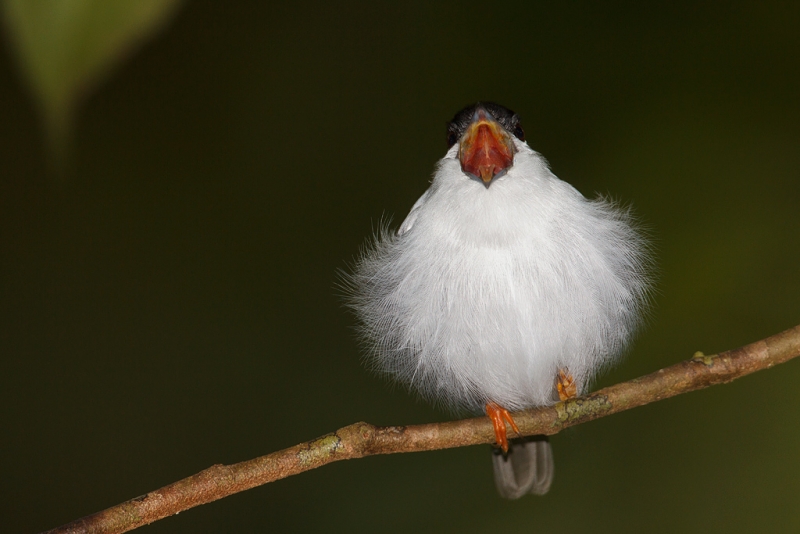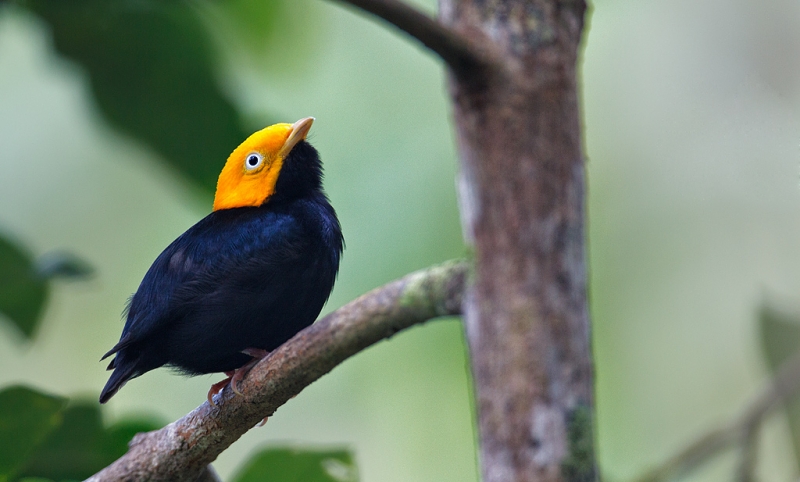|
This fluffed up male White-bearded Manakin was photographed with the tripod-mounted Canon 800mm f/5.L IS lens, the 1.4X III TC, and the Canon EOS-1D Mark IV. ISO 800. Evaluative metering at -1/3 stop: 1/50 sec. at f/10 in Manual mode. Quasi-flash as main light at -2/3 stop with the Canon Speedlite 600EX-RT with the Better Beamer. Central sensor (by necessity) AI Servo/Rear Focus AF and recompose. Click here if you missed the Rear Focus Tutorial. Click on the image for a larger version. |
Trinidadian Gems
On our first walk at the Asa Wright Nature Center in Trinidad Denise Ippolito and I have the pleasure of visiting the leks (dancing areas) of both White-bearded and Golden-Headed Manakins. It was not quite like shooting ducks in a barrel but after an hour or two of work we each had some nice images to show for our efforts. There are lots of tanagers and hummingbirds to photograph off the veranda but it was the little manakins that stole our hearts that first day.
|
This male Golden-headed Manakin was photographed with the tripod-mounted Canon 800mm f/5.L IS lens and the Canon EOS-1D Mark IV. ISO 1000. Evaluative metering +1/3 stop: 1/60 sec. at f/8 in Manual mode. Quasi-flash as main light at -2/3 stop with the Canon Speedlite 600EX-RT with the Better Beamer. Central sensor AI Servo/Rear Focus AF. Click here if you missed the Rear Focus Tutorial. Click on the image for a larger version. |
Quasi-Flash as Main Light Technique
Here I used a bit less flash than if I were using true flash as main light techniques and worked darker than if I had been using true fill flash techniques (where I would have needed an even slower shutter speed….) I relied on the flash to help create a sharper image while adding a bit of light to the near-background. In addition, flash always helps to restore the proper color balance when working under a canopy of trees.
To learn more about flash as main light and more about flash as fill see the Flash Simplified section of The Art of Bird Photography II (916 pages on CD only).
Favorite?
Take a moment to let us know which of the two images that you liked best, and why.
Shopper’s Guide.
Support both the Bulletins and the Blog by making all your B & H purchases here.
Below is a list of the gear talked about in this blog post. Thanks a stack to all who have used the Shopper’s Guide links to purchase their gear as a thank you for all the free information that we bring you on the Blog and in the Bulletins. Before you purchase anything be sure to check out the advice in our Shopper’s Guide.
Canon 800mm f/5.6L IS lens. Right now this is my all time favorite super-telephoto lens.
Canon EF 1.4X III TC. This new TC is designed to work best with the new Series II super-telephoto lenses.
Canon EOS-1D Mark IV professional digital camera body. The very best professional digital camera body that I have ever used.
Canon Speedlite 600EX-RT Canon’s latest/greatest most powerful-ever professional flash.
And from the BAA On-line Store:
LensCoats. I have a LensCoat on each of my big lenses to protect them from nicks and thus increase their re-sales value. All my big lens LensCoat stuff is in Hardwood Snow pattern.
LegCoat Tripod Leg Covers. I have four tripods active and each has a Hardwood Snow LegCoat on it to help prevent further damage to my tender shoulders 🙂 And you will love them in mega-cold weather….
GT3532 LS. This one replaces the GT3530LS Tripod and will last you a lifetime. I’ll be commenting on this new model soon. In short, I like it.
Mongoose M3.6 Tripod Head. Right now this is the best tripod head around for use with lenses that weigh less than 9 pounds. For heavier lenses, check out the Wimberley V2 head.
CR-80 Replacement Foot for Canon 800. When using the 800 on a Mongoose as I do, replacing the lens foot with this accessory lets the lens sit like a dog whether pointed up or down and prevents wind-blown spinning of your lens on breezy days by centering the lens directly over the tripod.
Double Bubble Level. You will find one in my camera’s hot shoe whenever I am not using flash.
The Lens Align Mark II. I use the Lens Align Mark II pretty much religiously to micro-adjust all of my gear an average of once a month and always before a major trip. Enjoy our free comprehensive tutorial here.
BreezeBrowser. I do not see how any digital photographer can exist without this program.
















I do like both of them for different reasons. Is the bill of the white one wide open? Or is the bill closed? Hard to tell but white fluff is still stunning.
The bill is wide open.
I love both of them, the golden headed especially. My mind is clouded with the fact that you were right in my backyard, and I did not get to meet you! I live in Trinidad and have been an avid follower of your blog for more than two years! Are you still here?!
Sorry that I missed your message. Internet service was sporadic at best. When I did see your message we were on our way to Tobago and then home the next day. Yikes!
The Manakin, for me better colors, more detail, the head of the first bird is hard to see clearly.
I much prefer the second image; the flash is subtle and unobtrusive. In the first, the flash is more obvious, and because the bird’s head is facing directly forward, its eyes are 90 degrees to the main light (flash) and therefore not well illuminated.
Just love that fluff-ball of a manakin!! Hope you post more of the Trinidad lovelies. Good info on the quasi-flash technigue.
I really like the Manakin Birds, that beardie should be called the Father Christmas Bird. But these little guys are amazing when they dance!